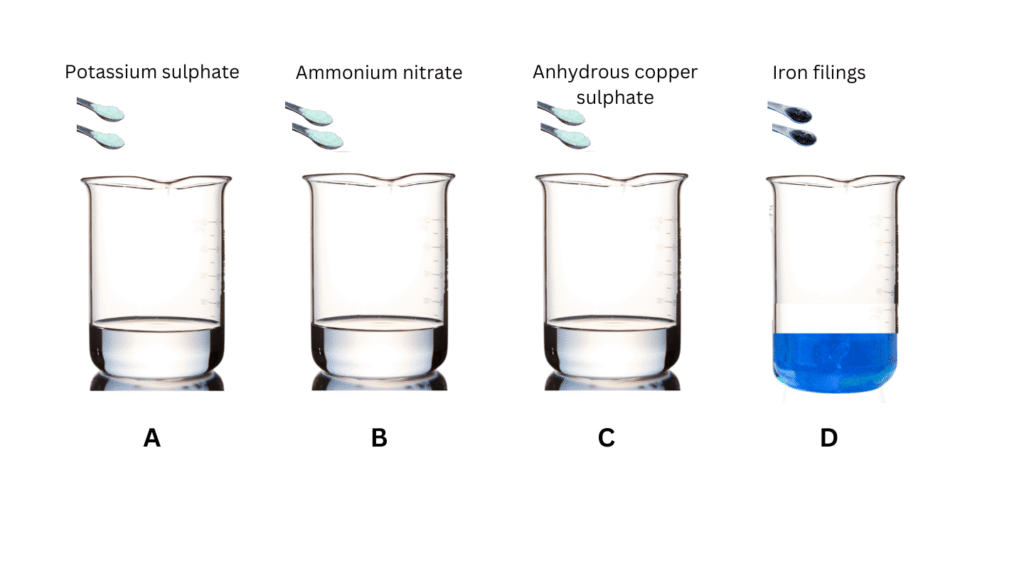Perform the following activity.
- Take four beakers and label them as A, B, C and D.
- Put 25 mL of water in A, B and C beakers and copper sulphate solution in beaker D.
- Measure and record the temperature of each liquid contained in the beakers above.
- Add two spatulas of potassium sulphate, ammonium nitrate, anhydrous copper sulphate and fine iron fillings to beakers A, B, C and D respectively and stir.
- Finally measure and record the temperature of each of the mixture above. Find out which reactions are exothermic and which ones are endothermic in nature.
Answer:
Aim: To determine which of the 4 reactions are exothermic and which ones are endothermic.
Materials Required: Four beakers, water,copper sulphate solution, potassium sulphate, ammonium nitrate, anhydrous copper sulphate and fine iron fillings, spatula.
Procedure:
(i) The beakers are labelled as A, B, C and D.
(ii) 25 mL of water is put in each of A, B and C.
(iii) 25 mL of copper sulphate solution is put in beaker D.
(iv) The temperature of the liquid in each beaker is measured and recorded.
(v) Two spatulas of potassium sulphate, ammonium nitrate, anhydrous copper sulphate and fine iron fillings are added to beakers A, B, C and D respectively and stirred.
(vi) The temperature of the solution in each beaker is measured and recorded again.

Observations:
The temperature recorded initially are shown below:
| Beaker | Temperature |
| A | 25oC |
| B | 25oC |
| C | 25oC |
| D | 25oC |
The final temperatures of the mixtures are shown below:
| Beaker | Temperature |
| A | 22oC |
| B | 20oC |
| C | 35oC |
| D | 55oC |
Conclusions:
- The reactions in beakers A and B involve a decrease in temperature and are hence, endothermic.
- The reactions in beakers C and D involve an increase in temperature and are hence, exothermic.
- The reaction of potassium sulphate in water is endothermic because in order for the molecule to be separated into its constituent ions energy is required, which is absorbed from the surroundings. Hence the temperature of the mixture decreases.
- The reaction of ammonium nitrate in water is endothermic because energy is required to separate the molecules into their constituent ions for dissolution. This is absorbed from the surroundings and hence the temperature of the mixture decreases.
- Anhydrous copper sulphate releases energy when dissolved in water and hence the temperature of the mixture increases.
- The reaction of iron filings in copper sulphate solutions also releases energy and hence the temperature of the mixture increases.
“Perform the following activity.
Finally measure and record the temperature of each of the mixture above. Find out which reactions are exothermic and which ones are endothermic in nature.
Take four beakers and label them as A, B, C and D.
Put 25 mL of water in A, B and C beakers and copper sulphate solution in beaker D.
Measure and record the temperature of each liquid contained in the beakers above.
Add two spatulas of potassium sulphate, ammonium nitrate, anhydrous copper sulphate and fine iron fillings to beakers A, B, C and D respectively and stir.” – Solved.
Related Links:
Solution to Group Activity
Solution to Activity 1.1
Solution to Activity 1.2
Solution to Activity 1.3
Solution to Activity 1.4
Solution to Activity 1.5
Solution to Activity 1.6
Solution to Activity 1.7
Solution to Activity 1.8
Solution to Activity
Solution to Activity 1.9
Solution to Activity 1.10
Solution to Activity 1.11


